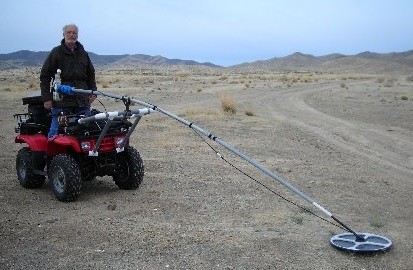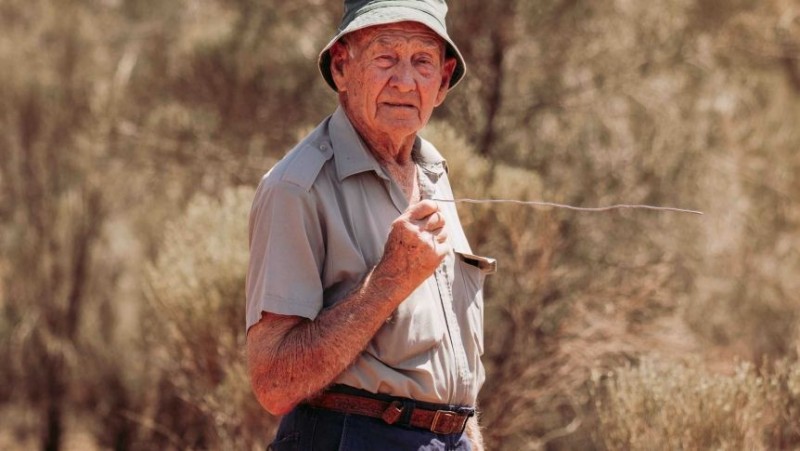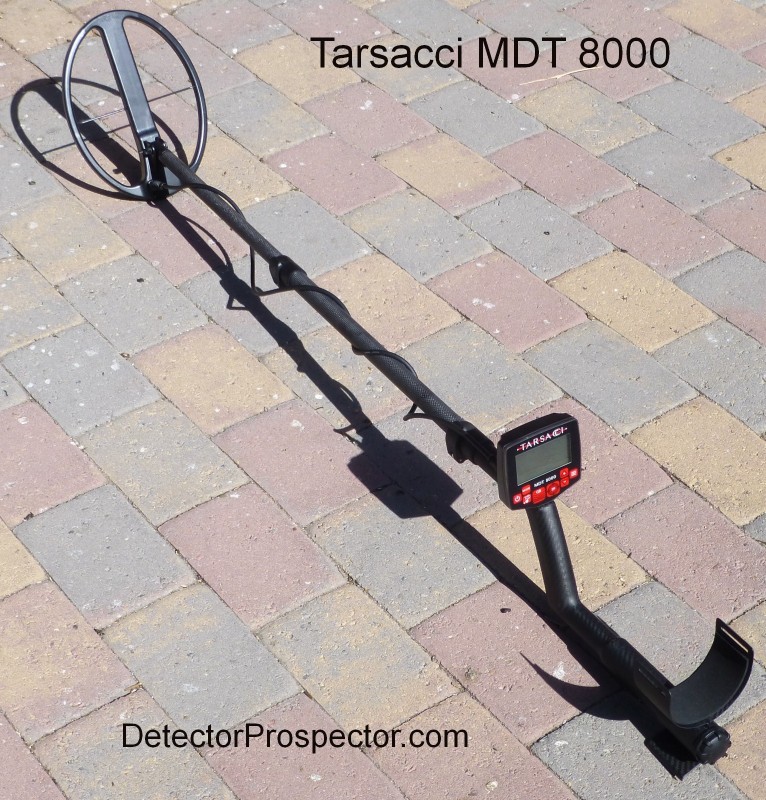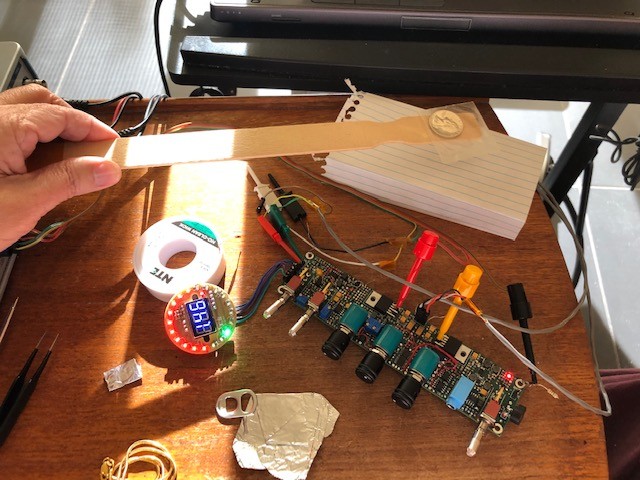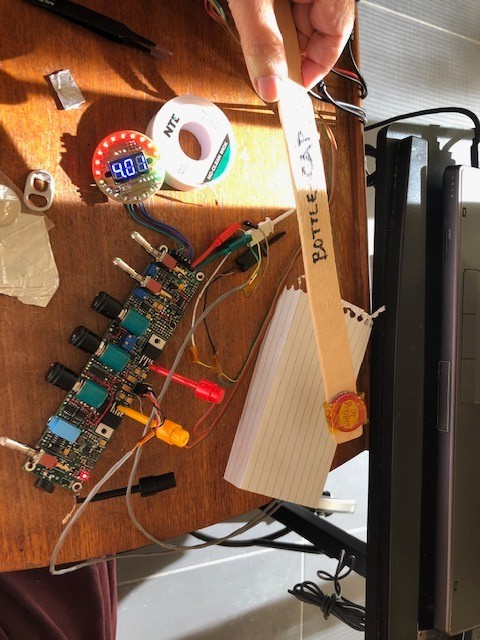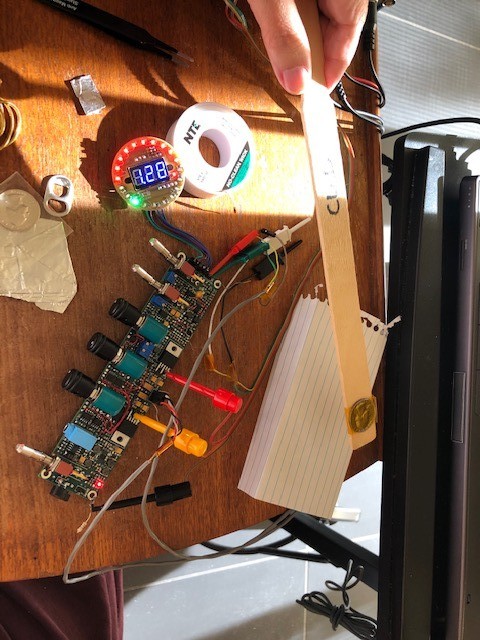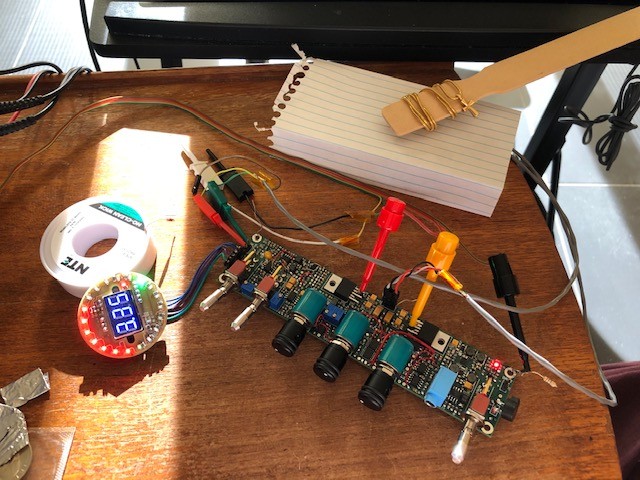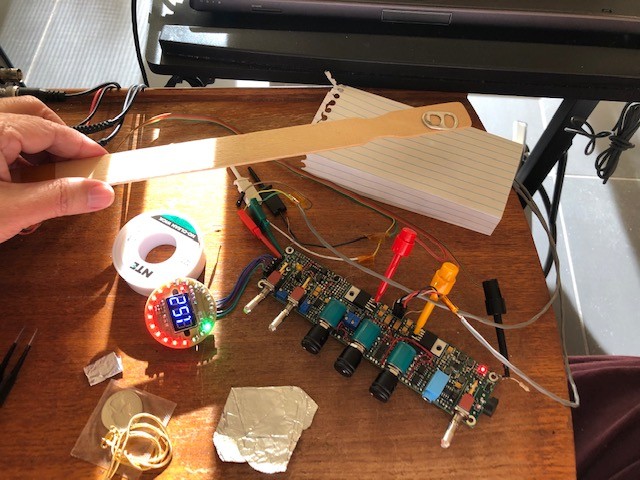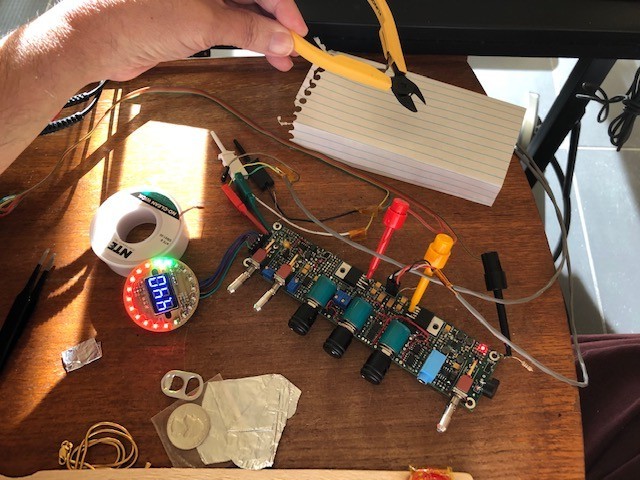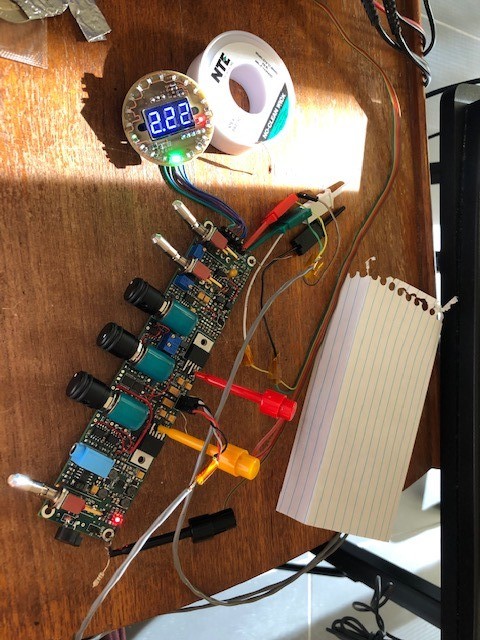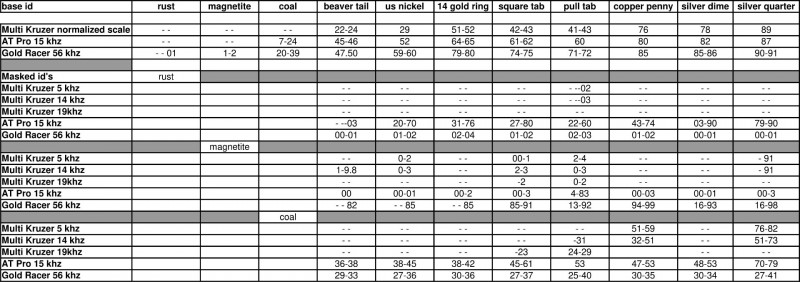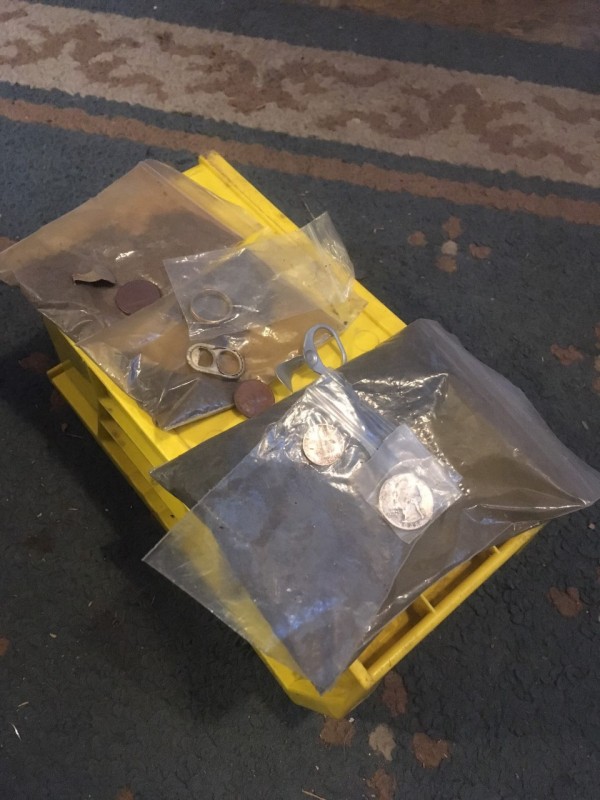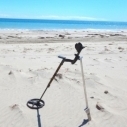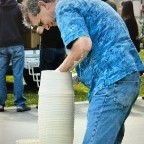Search the Community
Showing results for tags 'detector tech'.
-
Hey guys, Can someone explain to me in simple terms what is it and what we accomplish by using a slight ground balance offset (either positive or negative) on our machines? I remember for example that when using an Xp Deus in the past, whenever I needed some little extra depth boost I was manually set the GB a little lower than the actual ground phase of my area but in the expense of greater ground noise and instability...the opposite when I needed a more quiet run....However I never deep dived into this concept and never understood how and why this really worked. Would be great to understand this now, and in order to help me (and because each machine has a different GB scale), let's assume a Ground Balance scale of a Makro Multi Kruzer (which I'm expecting soon). So...In a Makro M. Kruzer, let's say that machine grabs (via pumping) a Ground Phase of 70 in our area... 1) What if I manually set my GB slightly HIGHER than 70 (eg at 75) regarding ground noise, depth abilities and targets detection? Will the effects be the same for both low & high conductors or tiny & large targets? 2) Same as above, what if I manually set my GB slightly LOWER than 70 (eg at 65) regarding ground noise, depth abilities and targets detection? Will the effects be the same for both low & high conductors or tiny & large targets? 3) Will this GB offset apply also in the salt water the same way? (I recently whatched a guy reviewing and using a Multi kruzer in the salt water, and he manually increased his GB value on purpose while he was trying to detect a small gold chain underwater...never understood why he did such a thing and how this works) 4) Lastly, please define which side is "positive GB offset" and which side is "negative GB offset" in Makro machines..... May sound obvious but, in some machines higher GB Phase means hotter ground but in some other machines higher GB Phase means milder ground (the opposite). So to tell me that "a Positive offset means moving the GB value to the hotter side of scale & the effects wil be that..." may mean nothing if I don't know which side is hot and which side is mild...hope that makes sense. I don't have a clue which side is hot & which is mild in Makro GB Scales so would be nice to enlighten me and correlate your answers with this! Hope my questions makes sense... Regards, Argyris
-
(Long article. If you think you'll get bored of the background info and stop in the middle, skip to the Testing section to see what a metal detector has to say.) Introduction Detectorists occasionally come across ceramic tableware/dinnerware at sites. For example, I found some in a ~1880's Colorado ghost town. A friend of mine found a piece (which I was able to identify and date to the 1890's) near a high altitude Colorado miner's cabin associated with a small silver mine. Western USA explorers/settlers/miners may seem backwards and uncivilized (and that is true in some cases) but often they longed for the finer things of the lives they left behind. Ceramic dinnerware was both utilitarian and aesthetic. Coin&relic detectorists around the world use pottery and other ceramic pieces, often found on the surface, to indicate good places to detect. In a previous life 😁 (actually 1998-2015) I was a avid (make that obsessed) collector of dinnerware by a particular USA manufacturer, accumulating a collection of 2000 pieces by scouring antique malls/shops but also occasionally other sources like rummage sales and Ebay. Not surprisingly I did a lot of research on the subject during my collecting years. Here are some results relevant to metal detecting. Plausibility In this first photo are two 6" diameter plates, both with filigree decoration and an edge line. The lower decoration is gold and the upper one is platinum (often mistakenly but understandably called 'silver'). The upper piece was manufacture in 1937 and the lower (gold) one in 1952. Each sold (usually as part of a set) for considerably less than $1 -- let's use $0.20 as a reasonable amount. Can we possibly reconcile these two 'facts' -- precious metals on inexpensive items? It is known that gold can be worked into very thin sheets. According to Wikipedia, typical gold gilding is 100 nm thick. ('nm' is the abbreviation for nanometer. There are a billion nm in a meter.) Scientists in the laboratory have done ~200 times better -- less than 0.5 nm which is actually about 2 gold atoms in thickness! Coatings on precision mirrors (e.g. astronomical instruments) are also about 100 nm in thickness -- same as fine gilding -- and that is thick enough to reflect in the high 90% decade at infrared wavelengths. About 15 years ago I took a tour of the Homer Laughlin China factory in Newell, West Virginia -- located in the very tip of that spike in West Virginia's NW part, along the Ohio River across from East Liverpool, Ohio and about 45 miles WNW of Pittsburgh, Pennsylvania. They actually took us to the factory floor and one of the things they showed us was a technician/artist painting the gold edge line on a piece. The claim was that it was pure gold (24 kt) but my research indicates it was more likely 22 kt. I calculated the approximate amount of gold on the edge line of the lower plate in the picture above and at today's price ($58.54/g) it comes out to about $0.06 worth. However, when that piece was made, gold was $35/oz (a factor of ~1/60 compared to today) so that material cost would have been more like $0.001 (at tenth of one cent) for a 6" plate. That certainly seems plausible, even if the thickness was several times that 100 nm assumption. Testing I used the Minelab Equinox 800 with 11" coil, Park 1 mode, gain of 24 in 10 kHz, 15, kHz, and 20 kHz modes (MultiFrequency too noisy with EMI) to see if the following soup bowl would give a signal. This is a rather extreme example in terms of the amount of platinum for an inexpensive piece of dinnerware to contain. The platinum band is 1/2 inch wide (1.27 cm) and the total calculated mass is about 0.011 g (assuming 100 nm thickness of pure platinum, so adjust accordingly). At today's price of $36.49 g those assumptions translate to $0.40 worth of platinum in this dish (I don't know the platinum spot price when it was manufactured in 1932). The digital Equinox's TID waffled between 1 and 2 and the signal strength was maximized when the coil was centered over the dish, with the coil about 1 inch above the platinum band, resulting in 3 arrows out of 5 ("depth meter" reading). Sweeping over the entire dish also gave a weak hit when the edge of the coil crossed the edge of the band. I also tested a similar sized dish which had just an edge line and filligree decoration similar to those shown in the first photo. There was no noticeable response by the detector on that one.
-
I noticed early on that in discussions about the conductivity of gold, that gold is considered a low conductor. This is confusing to me. My understanding was that gold is a high conductor, whereas only 2 other metals are higher conductors. Silver being the highest conductor, and copper being the next highest, allowed by gold. Iron is way down on the list. Can anyone please explain this?
-
Years ago I had a wise customer who was always trying to make things better. He spent much of his free time chasing gold nuggets at Rye Patch, NV in the 90's and early 2000's (when pickings were good). He always wanted to cover ground and chase the big ones. One time he calls me to order some Coiltek coil wiring (extension) as he has long dreams. I seen him out there with his new long shaft and boy was it longer than I had expected. Has anyone seen anything similar or just as crazy? On a side note, this beautiful Horse Nugget of 6 ounces was found in the road at Rye Patch proper. Seems most of us had walked over it for years thinking a beer can in the middle of the road when in fact it was the biggest piece of gold I have seen come from Rye Patch. I know one of my Staff found a 5+ oz'er one time and Chuck/Gracie from TX showed me a 5 oz'er, but this one has character. If anyone knows of bigger gold nuggets from actual Rye Patch proper or of a longer shaft on their Minelab, I'd love to see. Enjoy everyone and stay out of my swing path, all 30 feet of it.
-
Here's a piece of an ad that showed up on my browser page while reading the forum. I sometimes miss figuring things out but this one (on the surface) seems too far out there to have me fooled, but I never really know. The one on the left is particularly bizarre. Maybe just kids toys that don't actually work but make them think they are detecting? (I could have clicked the ad and gone to the site but I'm always concerned that this will lead to me being targeted by more of their ads.)
-
First, I new here so hello and thank you for contributing to this forum. I just purchased my first detector and am excited to get started in this hobby. I bought an xterra 705 with the 8x5 18.75khz coil to go along with the standard 7.5khz round coil. I'm hoping to take some trips looking for gold over the summer, but I live in Texas so I was also looking for a general purpose detector for parks, beaches, dinking around. I'm thinking this setup gives me a pretty solid all arounder to get started. I am wondering about the different coils for these things and how to get the most out of a singe detector. Obviously, the 8x5 will be my best option for small gold. My question is whether there would be a benefit to getting something like the 15" 3khz coil for larger or deeper gold? Would it be useful in this capacity? Would there be much difference from the stock 7.5 coil? I suppose I'm trying to ask if there's a way to get a VLF to work more like a PI detector. I'm guessing I also know the answer, but I'm asking anyway. What do you guys think? Useful or money better saved?
-
While this topic is hot and on our minds, I'm going to make a request. Could someone with detailed technical & engineering knowledge write up a report explaining Iron Bias at an intermediate-to-advanced user but still layman's level? The kind of description I'm requesting is one similar to what was done in Randy Horton's excellent monograph Understanding Your X-TERRA which contains an interview with Minelab scientist&engineer Dr. Laurence Stamatescu (starting on page 79) where he melds the right combination of technical info and easy to follow wording. Maybe there has already been such a writeup that I'm not aware of, but although I appreciate what has been posted here on the forum on this subject I'm still confused/confounded as to what is going on and how to best utilize it. I don't seem to be alone on that. One of my many gaps in understanding is whether or not all detectors have an effective (but fixed) iron bias setting, with only a few giving the user the option of dialing it in for best performance. Related: when iron bias on the MInelab Equinox is set to zero (in either F2 or FE), is there still some kind of iron bias occurring? Knowing how a detector works transfers over to optimizing it's use and I'd like to do more of that instead of just locking iron bias on one value for all applications and conditions (or blindly accepting factory defaults) -- what I (and apparently most users) do now based upon ignorance. (Well, I'm ignorant on this subject -- not trying to associate that with any of you. 😏)
-
Ok folks, someone please tell me this is just a bizarre series of coincidences. On three separate occasions now I've come across a good signal out in the forest here in Virginia, usually in the pulltab range, and dig only to find a hibernating snake. How in the world is that possible? Is the metal detector actually detecting the snake or are they just over a target? I can't figure this out. Any old hands wanna chime in here?
-
Is this the future of detecting? I think so. Take a set of data points and process them (just as we do with our brains) and voila! It doesn't have to be magic when you have good science to make it repeatable. Watch out missed nuggets! Currently, a type of software based on a machine-learning algorithm called deep learning has been shown to be effective at removing the blurriness or noise in images. These algorithms can be visualized as consisting of many interconnected layers or processing steps that take in a low-resolution input image and generate a high-resolution output image. https://scienceblog.com/520757/smart-algorithm-cleans-up-images-by-searching-for-clues-buried-in-noise/?utm_source=feedburner&utm_medium=email&utm_campaign=Feed%3A+scienceblogrssfeed+(ScienceBlog.com)
-
We all have seen many videos comparing metal detectors , changing the coils, frequencies and all kind of settings so they can maximize the capabilities of the "machines"! But what about the same machines abilities to detect larger targets like a 20x20 cm or 40x30cm on greater depths?? Am in the only one Qurious about it 🤪 Have someone seen something about it??
-
Have you modded a detector or a coil over the years to make it perform better than the manufacturer intended? Did you get good results? I just did a search on this forum and found 168 hits for modded. What is your favorite mod?
-
I have got up on my soapbox every year about this time to prognosticate about the coming year in metal detector technology. 2020 was an especially significant year as we lost another major player in the industry. A few years ago it was Tesoro going out of business. In 2020 we learned that White's is closing shop and being acquired by Garrett. It is unknown if Garrett will attempt to keep White's alive as a separate product line, or simply acquired the rights and technology to keep somebody else from doing so. At the moment it seems White's has gone away for good, but it is not impossible Garrett will revive the name in 2021. Whatever they decide will have a major influence on metal detecting in the future. But in the meantime we have fewer players now to speculate about. Garrett/White's - we just saw the release of the Ace Apex, a first foray into multifrequency by Garrett. The company already has a very well implemented wireless audio system, and the Apex is fully rechargeable. The White's acquisition means Garrett adds the V3i multi tech and TDI PI tech to their IP base, and this along with the half-sine patent means Garrett has a fresh shot of technology options to choose from. The White’s 24K is a superb product, now unavailable new. However, I expect an acquisition of this magnitude to take time and I'm not holding my breath on any really new product in 2021 from Garrett. At most perhaps a revival of some White's models, or releasing clones under the Garrett name. At the moment however I see Garrett as the U.S. company with the most potential for the longer term future, regardless of what happens in the near term. First Texas (Bounty Hunter, Fisher, Teknetics) - whereas Garrett seems to have a purpose, First Texas seems adrift these days. Most of the Fisher models on the website have been discontinued, or are decades old. Teknetics as a brand seems nearly dead, focused on factory direct sales. Basic advances like in-built rechargeable battery systems, wireless headphones, and over the internet updates - all go ignored at the company. The only news is a new line of pulse induction detectors, but as the lack of interest from users on the internet shows, most people are not screaming for First Texas to bring a PI to market. Everyone wants to hear about a major response to new machines like the Equinox, but so far it's crickets from First Texas. The final production Impulse AQ will hit the market in the first half of the year, but I expect it to have almost no impact on the overall detecting world, or even the beach detecting world for that matter. People will still choose VLF over PI for beach detecting by huge margins, so the Impulse AQ has a shot at being nothing more than a niche detector in a niche detecting market. The Gold version has potential to crack open the gold prospecting market that Minelab currently dominates, but it is going to have to have a very attractive price/performance ratio if it hopes to make Minelab users consider a new brand. For many gold prospectors Minelab currently is the only choice in detectors. Hopefully there is more going on at First Texas than PI, because they are sliding into irrelevance in high end VLF. It seems more models keep slipping into the Bounty Hunter lineup, and if nothing changes someday the Teknetics and even Fisher lines may be retired. Or the Fisher line could be boosted with new high end machines to become the high tech alternative to Bounty Hunter. That was the original plan buying this old name in detecting, and 2021 will probably determine what happens for the Fisher brand in the future. Revival... or the next slow death? Minelab - on a roll still, with the new GPX 6000 due out this spring. When it comes to cutting edge technology, Minelab remains the company to watch. There is no doubt a replacement for the CTX 3030 in the works, but there are no solid hints at when it may arrive. I am guessing 2022 since the last two rollouts were for coin detectors (Equinox and Vanquish). Minelab tends to address areas in a round robin fashion, and I believe 2021 will preferentially freshen the gold prospecting lineup. Nokta/Makro - the easy picking low hanging fruit of single frequency VLF has been fully exploited at Nokta/Makro, and it remains now to see if they can make the move up to higher tech product like simultaneous multifrequency and ground balancing pulse induction. The rapid pace of new product releases has stalled out as further advances will be more difficult. Historically NM has used their Christmas card to hint at new releases, and this year they took a pass on that. I'm hopeful for 2021 but certainly not holding my breath, as it may be fall at earliest before we hear more. Tarsacci - a new 12" coil for the MDT is in the works, and a possible change to the battery door design in future versions. XP - still largely a one-trick pony with the DEUS, and the ORX, which is really just a subset of the DEUS. Will we ever see multifrequency or PI from XP? All is quiet now with the news over ORX run it's course, and right now there are no hints of anything new from XP for 2021. Just random blatherings from an industry old-timer, worth every penny paid. I'm pretty well set for detectors these days, with only the grudge match between the Minelab GPX 6000 and Fisher Impulse Gold having any interest for me personally. I have to put my money on Minelab when it comes to cutting edge tech, but I do hope the Impulse Gold is good enough and low priced enough to shake things up.
-
Hi Folks, Thought I would start a thread showing my first attempt at an analog detector, I've been working in the electronics field for many years mostly in the analog/rf area. Hope everyone enjoys the process, and any input or suggestions would be appreciated. I'll try and post as I go along, but this is my after hours hobby, so updates may come every few weeks. I apologize if this goes overboard on the images. So here goes..... Here is the overall unit, the display will tip up and turn on. Closeup of the display Display tipped up, it will show RSSI across the top, and material ID in the center and across the bottom. Control Panel, has gain hi lo, discrimination on off, coil balance, threshold, volume, phone jack, and on off with lo bat indicator. Coil Actual board and display turned on and balanced, I'm sorry for the vertical image I couldn't straighten it up, the coil is under the paper, it's a hand wound 3" OD test coil. Note that this board has only three adjustments and the one in the above renderings has four, this one has no threshold adjust. 1957 silver quarter Gold chain and cross. Aluminum pull tab. Coke bottle cap. Clad quarter. My steel cutters. I'm getting parts in to start putting the new one together, hopefully my updates to the circuit will work out. We have a saying, "may have to shoot the engineer to finish the project", it feels like every other day I come up with another improvement :), anyway I hope you guys enjoy this, I'll post as I go along. -Sun-Boy
-
Hey folks, new to the forum here. I am working and playing in the state of Alaska, and live in a decent gold bearing area, but it’s mostly flour gold from glacial dust.... geologically speaking it’s pretty young soil with lower levels of mineralization (I was told). The area was never thoroughly mined, because of the difficulties encountered extracting this fine stuff with old methods. Anyway, I have been picking some old-timer’s brains on how to get started, and he suggested this method for this fine stuff.... he liked to locate the mineralization zones with a detector, then dredge or sluice that. That way he would only process the more concentrated material. There are the occasional nuggets, but very scarce compared to the flour. is this a realistic method for doing a little weekend prospecting? I have been looking into detectors (the last one I had was 15 or 18 years ago and it was a very basic bounty hunter great for a kid, but....) seemingly most detectors are trying to tune out the mineralization, and I am searching for it. I was looking at the gold monster 1000, and equinox, but can’t decide if their advanced discrimination would help or hinder my goals. Any thoughts on this technique, and what machines to consider to achieve the goal? Of course I’d like something that could treasure hunt, and do everything else great too, but I know that’s not usually how this stuff works. Thanks for your time and patience. In the meantime I am going to be educating myself on the forum. Trying to soak up all this knowledge.
-
I just had a pacemaker installed and I’m having trouble finding info on using my metal detectors with it. Just wondering how the detector batteries and EMI will affect my pacemaker. Maybe the only thing I’ll have to worry about is whether it will implode if I swing across a really big nugget? 😳 Hopefully I can keep detecting with no problems from the pacemaker or my heart! Thanks for any input. P. S. I understand if anyone is hesitant to answer because of liability issues. That’s one reason I’m having trouble getting info including from Minelab. Can’t blame anyone for that. Just general info or experiences from anyone that has a pacemaker would help. My doctor has a bad “bedside manner”. The one time I met with him before he slapped it in me was frustrating. He had a standard response to my questions. “Get it or you die”. He is a highly skilled and highly recommended jerk. Maybe I can get some answers on my follow up app’t but not counting on it.
-
Been meaning to do this test for a while. I used 3 machines that have VDI. Multi Kruzer, AT Pro and Gold Racer. Test was done as follows: Plastic bin 5" high with masking materials above and targets placed directly below. 3 different masks were used: 1 rust, 2 magnetite, 3 crushed coal. All 3 placed into baggies to avoid miserable cleanup after and bags were layed flat with material distributed as even as possible within the bag. All machines set at 80% gain/sensitivity. the Multi Kruzer had the Super Fly coil which I kept on as it is most likely similar to the Simplex 11" and Amphibio stock 11" in performance and separation. AT Pro had stock 8 1/2 x 11 dd and the Gold Racer had the stock 5 1/2 x 10. The Multi Kruzer was run in 3 tone mode, AT Pro in Zero mode, and the Gold Racer in disc 1 with imask 1. I indicated "- -" where there was no ID on display but often especially on the Multi Kruzer there was clear audio of the object below. Targets were: Beaver Tail, US Nickel, 14k Gold Wedding Band, Square Tab, Pull Ring, Copper Penny, Silver Dime and Silver Quarter. This test is much more extreme than what you would typically run into in actual occurances but gives an idea on how machines respond. The masked materials gave little or no audio response but the mineral meters on the Kruzer and Racer were really high. This is important when out in the real world detecting to pay attention to the mineral meter if your machine has it then double check those targets as possibly being of value. Don't move on if you hear an iron grunt. Be nice to see similar tests with an Apex, Nox and Vanquish line up.
-
Given that the latest crop of detectors can be updated with new features simply by downloading software updates, how long will it be until manufacturers offer a cheap base model with pay as you go additional features and capabilities. Want more tone options, prospecting ability, custom frequencies, simply pay a small fee and download to your detector. On the same token have to ability to remove unused or unwanted features to de-clutter your detector, and with the ability to load them up again at a later date as needed. This would give the ability for a beginner to grow with their simplified base detector, adding new features as experience is gained and as budget allows, whilst still maintaining a budget initial purchase price. We also often talk about detectors being too overwhelming or complicated to learn for newcomers, so sometimes less is more. The downside for manufacturers is that it would do away with multiple models of detectors, often earmarked by minimal incremental changes to justify producing a new or improved detector. Good for the consumer, maybe not so much for profit margins. In a way it is already happening with detectors like the XP Deus, with constant updates to extend the lifespan of the platform, though hardly a budget detector and the updates are actually free. Any extra costs/profits are made via accessory coils and other add-ons like pinpointers vs charging for added features alone (some new features necessitate the purchase of new accessory coils to be activated). You do have to appreciate that the Deus's lifespan amazingly started out in 2009, proof that a single platform can last the test of time and still be relevant even today. Imagine a base version of an improved Simplex with added hardware/software ability to run multi-frequency and/or individual frequencies, then being able to unlock MF ability down the track as budget allows. It is not always the case the one can afford the initial cost of a fully loaded detector out of the box, nor want to purchase multiple detectors to gain added features and performance. Silly idea or does it have some merit?
-
Metal detecting has a lot of jargon that makes little sense to beginners. I’ve thought about starting a list on this website, but the fact is it’s been done in quite a few places already. While I still might put one together myself, for now here is a link that can give you all the definitions anyone might need. Metal Detector Terms & Definitions via Google Tesoro put out a great catalog in 2010 that included a lot of extra information, including a glossary starting on page 58. You can download it for free here.
-
Greetings to all! My name is Alexander, I am from Ukraine (Eastern Europe). I represent myself and my friends, we developed a portable type GPR many years ago and gave it the name EasyRad. We have developed a georadar and software for it. We would like to get in touch (get contact) with those people or organizations who need to search for gold in the United States and Alaska. To my regret, on forums of gold prospectors and forums of archaeologists there are no sections "georadars", there are only metal detectors. I would like to convey to the searchers the information that GPR is not expensive and it allows you to explore underground spaces quickly and with great interest 🙂 We produce this GPR equipment, so we can answer all your questions. Our radar has a very affordable price for individual use, unlike other radars. See the web link below for examples. EasyRad GPR is a portable multi-purpose scanning ground penetrating radar of sub-surface probing for the problems of engineering geology, hydrogeology, archeology, ecology, field engineering as well as for search and rescue operations. https://www.easyrad.com.ua/index.php?r=index_en
-
So for you experts on EMI interference. Does EMI effect the powerhead?, coil? or both???? Thanks.
-
Is there now marketed or has there ever been available a detector which inverts the audio volume scale? Many applications produce better finds from the weaker signals, either because those items are smaller (e.g. micro jewelry) or deeper (e.g. old coins and nuggets). Having to listen through the din of trash to hear the weak signals for most detectors is mentally fatiguing. I wouldn't be surprised if this is/was possible with analog electronics, but seems like a task that digital processing could handle easily(?).
-
I posted this in the vanquish thread but it’s buried fairly deep so I’m asking here too, about the vanquish, it’s multi iq technology rooted in VLF technology or is it something different all together? I was under the impression this is a multi frequency VLF detector that basically samples multiple VLF frequencies simultaneously to better I D targets and while the way it makes this possible is unique the signal would have the same limitation in heavily mineralized soil same as any VLF detector?
-
Winter will be starting to set in soon, and cabin fever will soon be running rampant , time to think about the next dream machine from Minelab. What improvements would you like to see over the Nox 800? Preformance is always a biggie. More depth, more Stable ID at that depth. Wider numerical ID system, 0-100. Better selection of optional size coils. Or, maybe an etrac or explorer features in the nox liteweight style? Adjustable handgrip pod. EMI elimination system. If you request it, maybe they will build it. 😁





